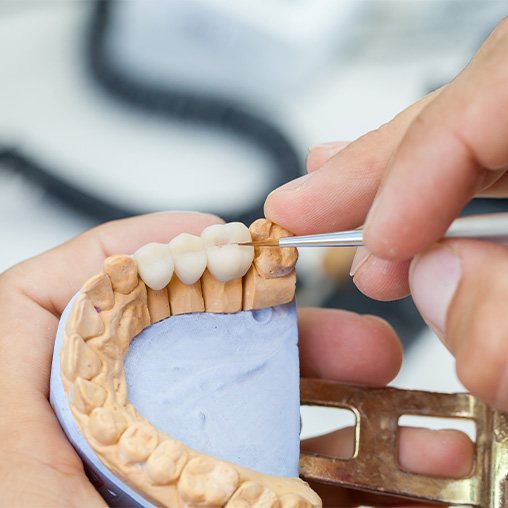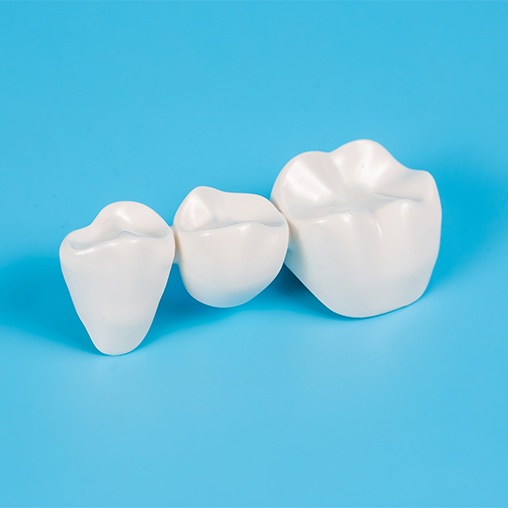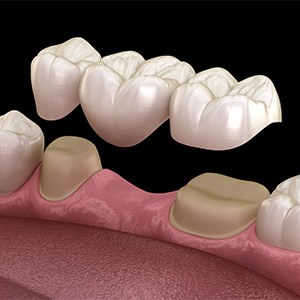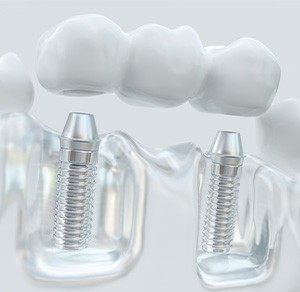Dental Bridges New Brighton
Fill the Gaps in Your Smile

The loss of a few teeth (or even just one tooth) might seem like it is not a big deal, but the truth is that any gap in your smile can adversely affect your oral health. If the empty space is toward the front of your mouth, your confidence may also be affected. The good news is that Dr. Helal and the team at Crescent Dental in New Brighton offer smart tooth replacement solutions, including dental bridges. Continue reading below to learn more about this treatment option.
Why Choose Crescent Dental for Dental Bridges?
- High-Quality, Lifelike Materials
- No-Mess Digital Dental Impressions
- Friendly & Courteous Dental Team
What Is a Dental Bridge?

A dental bridge is a multi-unit dental prosthetic that is designed to replace one or more missing teeth in a row. Bridges can be made of various materials. In our office, we tend to favor lifelike materials that bear a strong resemblance to natural tooth enamel, including Emax, zirconia, and porcelain.
Bridges are permanently fixed in the mouth. They are sturdy, highly functional, and designed to stand the test of time.
Types of Dental Bridges

There are a few different types of dental bridges, with traditional fixed bridges and implant bridges being the most common options. When you come in for your consultation, Dr. Helal will examine your mouth and learn about your circumstances before making a treatment recommendation. Here is a brief overview of each option:
Traditional Dental Bridges

A traditional dental bridge has a crown on each end, which support one or more pontics (artificial teeth) between them. The crowns are attached to the natural teeth (called abutment teeth) that surround the empty space. Traditional bridges are popular because they are sturdy, long-lasting, and relatively affordable. One potential downside is that they require the abutment teeth to be significantly modified in order to support their crowns.
Implant Bridges

Instead of being supported by natural teeth, an implant bridge is anchored in the jawbone via prosthetic tooth roots (dental implants). Therefore, no modification of nearby teeth is necessary. Implant bridges are also incredibly strong and can help to preserve the structure and integrity of the jawbone. We often recommend dental implants as the best form of tooth replacement.
The Benefits of Getting a Dental Bridge

A dental bridge has the potential to:
- Restore the appearance of your smile.
- Prevent your remaining teeth from shifting into the gap and causing a misaligned bite.
- Improve your ability to chew and speak properly.
- Support your facial structure and (in the case of implant bridges) prevent bone loss.
- Serve as a long-lasting and durable solution for missing teeth.
- Boost your confidence and self-esteem.
Are you ready to learn more about dental bridges and their benefits? Contact our New Brighten dental office today to request a consultation.
Dental Bridges FAQs
How Do I Clean Under My Dental Bridge?
Even as you brush a dental bridge like natural teeth, you should also clean beneath it. (Bacteria will build up and cause bridge failure otherwise.) That said, the best way to do this “down-under” cleaning can vary.
One option is to use dental floss creatively. By looping this string through a threader, you could slide the pointed end beneath your bridge and out the other side. You’d then be able to move the floss back and forth beneath your restoration. Afterward, you could wrap the floss around each of your abutments/implants to clean the gums there.
Another idea is to use an interdental brush. Also known as an interproximal brush, this tool consists of puffy bristles attached to a wire. It could easily slide into the space under your bridge to remove debris.
Can Dental Bridges Get Cavities?
A dental bridge will never get cavities; the device is artificial and lacks enamel. However, the natural teeth connected to it still can.
Don’t forget that food debris can get caught in and around a dental bridge. As that happens, harmful bacteria and plaque can build up and decay your abutment teeth. These substances could even cause a gum infection if left alone for too long.
Given these facts, remember to clean under and around your bridge daily. Proper brushing and flossing habits will keep your abutment teeth healthy and stable.
Do Dental Bridges Look Natural?
Rest assured that today’s dental bridges look quite natural. Once your own is placed, you can expect it to blend seamlessly with the rest of your smile.
For starters, note that our dental bridges are made from porcelain, zirconia, and Emax. Dental labs can color-match these metal-free materials to look exactly like your other teeth. By doing so, they’ll ensure your final bridge bears a lifelike resemblance to enamel.
A dental bridge is also designed to remain highly rooted, stable, and secure over time. Thanks to its abutments or implant posts, it won’t slip around or fall like a traditional denture might. That means your bridge won’t move in ways that make it look fake.
Do Dental Bridges Feel Natural?
After a few days of use, dental bridges usually feel pretty natural. They won’t draw your attention to unwanted or unpleasant sensations.
This “naturalness” partly stems from dental bridge materials. Since porcelain, zirconia, and similar substances are durable, they can withstand everyday chewing forces as easily as enamel can. It follows that using a bridge to eat food won’t feel strange.
Another reason dental bridges feel natural is their custom design. These devices are based on impressions of your mouth, so they won’t feel awkward or noticeable once placed.

